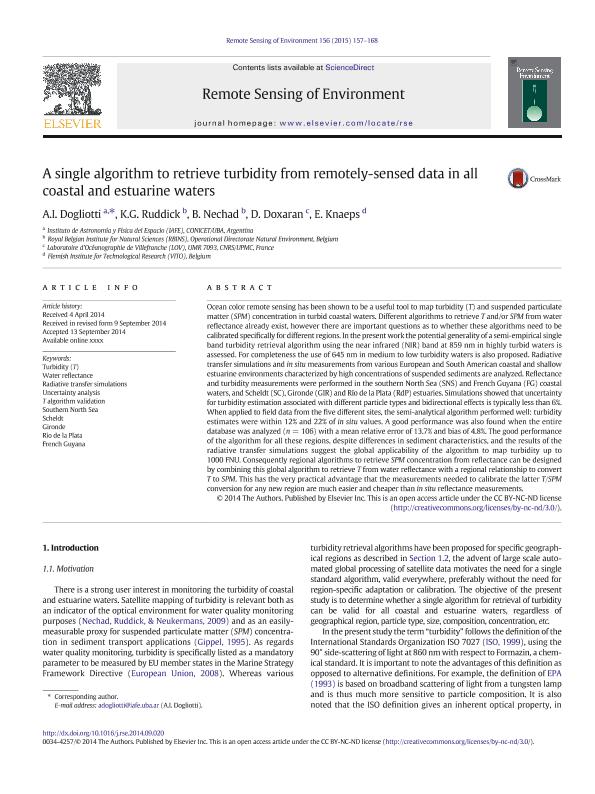Mostrar el registro sencillo del ítem
dc.contributor.author
Dogliotti, Ana Inés

dc.contributor.author
Ruddick, K. G.
dc.contributor.author
Nechad, B.
dc.contributor.author
Doxaran, D.
dc.contributor.author
Knaeps, E.
dc.date.available
2017-05-18T21:46:57Z
dc.date.issued
2015-01
dc.identifier.citation
Dogliotti, Ana Inés; Ruddick, K. G.; Nechad, B.; Doxaran, D.; Knaeps, E.; A single algorithm to retrieve turbidity from remotely-sensed data in all coastal and estuarine waters; Elsevier Science Inc; Remote Sensing Of Environment; 156; 1-2015; 157-168
dc.identifier.issn
0034-4257
dc.identifier.uri
http://hdl.handle.net/11336/16701
dc.description.abstract
Ocean color remote sensing has been shown to be a useful tool to map turbidity (T) and suspended particulate matter (SPM) concentration in turbid coastal waters. Different algorithms to retrieve T and/or SPM from water reflectance already exist, however there are important questions as to whether these algorithms need to be calibrated specifically for different regions. In the present work the potential generality of a semi-empirical single band turbidity retrieval algorithm using the near infrared (NIR) band at 859 nm in highly turbid waters is assessed. For completeness the use of 645 nm in medium to low turbidity waters is also proposed. Radiative transfer simulations and in situ measurements from various European and South American coastal and shallow estuarine environments characterized by high concentrations of suspended sediments are analyzed. Reflectance and turbidity measurements were performed in the southern North Sea (SNS) and French Guyana (FG) coastal waters, and Scheldt (SC), Gironde (GIR) and Río de la Plata (RdP) estuaries. Simulations showed that uncertainty for turbidity estimation associated with different particle types and bidirectional effects is typically less than 6%. When applied to field data from the five different sites, the semi-analytical algorithm performed well: turbidity estimates were within 12% and 22% of in situ values. A good performance was also found when the entire database was analyzed (n = 106) with a mean relative error of 13.7% and bias of 4.8%. The good performance of the algorithm for all these regions, despite differences in sediment characteristics, and the results of the radiative transfer simulations suggest the global applicability of the algorithm to map turbidity up to 1000 FNU. Consequently regional algorithms to retrieve SPM concentration from reflectance can be designed by combining this global algorithm to retrieve T from water reflectance with a regional relationship to convert T to SPM. This has the very practical advantage that the measurements needed to calibrate the latter T/SPM conversion for any new region are much easier and cheaper than in situ reflectance measurements.
dc.format
application/pdf
dc.language.iso
eng
dc.publisher
Elsevier Science Inc

dc.rights
info:eu-repo/semantics/openAccess
dc.rights.uri
https://creativecommons.org/licenses/by-nc-nd/2.5/ar/
dc.subject
Turbidity (T)
dc.subject
Water Reflectance
dc.subject
Radiative Transfer Simulations
dc.subject
Uncertainty Analysis
dc.subject
T Algorithm Validation
dc.subject
Southern North Sea
dc.subject
Scheldt
dc.subject
Gironde
dc.subject
Río de La Plata
dc.subject
French Guyana
dc.subject.classification
Oceanografía, Hidrología, Recursos Hídricos

dc.subject.classification
Ciencias de la Tierra y relacionadas con el Medio Ambiente

dc.subject.classification
CIENCIAS NATURALES Y EXACTAS

dc.title
A single algorithm to retrieve turbidity from remotely-sensed data in all coastal and estuarine waters
dc.type
info:eu-repo/semantics/article
dc.type
info:ar-repo/semantics/artículo
dc.type
info:eu-repo/semantics/publishedVersion
dc.date.updated
2017-05-18T15:36:16Z
dc.journal.volume
156
dc.journal.pagination
157-168
dc.journal.pais
Países Bajos

dc.journal.ciudad
Amsterdam
dc.description.fil
Fil: Dogliotti, Ana Inés. Consejo Nacional de Investigaciónes Científicas y Técnicas. Oficina de Coordinación Administrativa Ciudad Universitaria. Instituto de Astronomía y Física del Espacio. - Universidad de Buenos Aires. Facultad de Ciencias Exactas y Naturales. Instituto de Astronomía y Física del Espacio; Argentina
dc.description.fil
Fil: Ruddick, K. G.. Royal Belgian Institute For Natural Sciences ; Bélgica
dc.description.fil
Fil: Nechad, B.. Royal Belgian Institute For Natural Sciences ; Bélgica
dc.description.fil
Fil: Doxaran, D.. Laboratoire D; Francia
dc.description.fil
Fil: Knaeps, E.. Flemish Institute For Technological Research; Bélgica
dc.journal.title
Remote Sensing Of Environment

dc.relation.alternativeid
info:eu-repo/semantics/altIdentifier/url/http://www.sciencedirect.com/science/article/pii/S0034425714003654
dc.relation.alternativeid
info:eu-repo/semantics/altIdentifier/doi/https://doi.org/10.1016/j.rse.2014.09.020
Archivos asociados
